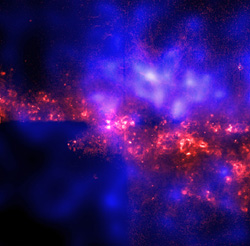|
Descent of Man In this lecture, beginners can familiarize themselves with basic information and terms used to describe the evolution of humanity beginning with the origin of primates through the comings and goings of Genus Homo. |

Chandra Detects Halo Of Hot Gas Around Milky Way-Like Galaxy
Posted: Friday, July 20, 2001
Source: NASA/Marshall Space Flight Center (http://www.msfc.nasa.gov)

The first unambiguous evidence for a giant halo of hot gas around a nearby, spiral galaxy much like our own Milky Way was found by astronomers using NASA's Chandra X-ray Observatory. This discovery may lead to a better understanding of our own galaxy, as well the structure and evolution of galaxies in general.
A team of astronomers, led by Professor Daniel Wang of the University of Massachusetts, Amherst, observed NGC 4631, a spiral galaxy approximately 25 million light years from Earth with both Chandra and NASA's Hubble Space Telescope.
While previous X-ray satellites have detected extended X-ray emission from this and other spiral galaxies, because of Chandra's exceptional resolution this is the first time that astronomers were able to separate the individual X-ray sources from the diffuse halo. Chandra found the diffuse halo of X-ray gas to be radiating at a temperature of almost 3 million degrees.
"Scientists have debated for over 40 years whether the Milky Way has an extended corona, or halo, of hot gas," said Wang, lead author of the paper which appeared this month in The Astrophysical Journal Letters. "Of course since we are within the Milky Way, we can't get outside and take a picture. However, by studying similar galaxies like NGC 4631, we can get an idea of what's going on within our own galaxy."
The Chandra image reveals a halo of hot gas that extends for approximately 25,000 light years above the disk of the galaxy. One important feature of the X-ray emission from NGC 4631 is that it closely resembles the overall size and shape seen in the radio emission from the galaxy. This indicates that there may be a close connection between the outflows of hot gas, seen in X-rays, and the galaxy's magnetic field, revealed by radio emission.
The Hubble image of NGC 4631 shows filamentary, loop-like structures enclosing enhanced X-ray-emitting gas and emanating from regions of recent star formation in the galaxy's disk. These data clearly show the hot gas is heated by clusters of massive stars and is now expanding into the halo of the galaxy.
"What we see in NGC 4631 can be thought of as the bursting flames of a gigantic cosmic camp fire," said Wang. "Using Chandra and Hubble together, we really get a complete story of what is happening in this galaxy."
NGC 4631 is a galaxy that has high amounts of star formation, possibly triggered by interaction with neighboring galaxies. Such star formation might have created the conditions necessary to heat the gas seen by Chandra, as vast amounts of energy are released from supernovae and massive stars in star-forming regions - enough to lift the gas out of the plane of the galaxy.
These new results provide important clues about the cycling of energy and mass in a galaxy like our own Milky Way and about the evolutionary history of galaxies, which are thought to be more active in star formation in the past than at the present.
###
Other members of the research team include: Stefan Immler, University of Massachusetts; Rene Walterbos, New Mexico State University; James Lauroesch, Northwestern University, Evanston, Ill., and Dieter Breitschwerdt, Max Plank Institute, Germany.
Chandra observed NGC 4631 with its Advanced CCD Imaging Spectrometer (ACIS) instrument, which was developed for NASA by Pennsylvania State University, University Park, and Massachusetts Institute of Technology, Cambridge. NASA's Marshall Space Flight Center in Huntsville, Ala., manages the Chandra program, and TRW, Inc., Redondo Beach, Calif., is the prime contractor for the spacecraft. The Smithsonian's Chandra X-ray Center controls science and flight operations from Cambridge, Mass.
Images associated with this release are available at:
http://chandra.harvard.edu
and
http://chandra.nasa.gov
Editor's Note: The original news release can be found at
http://www1.msfc.nasa.gov/NEWSROOM/news/releases/2001/01-248.html



